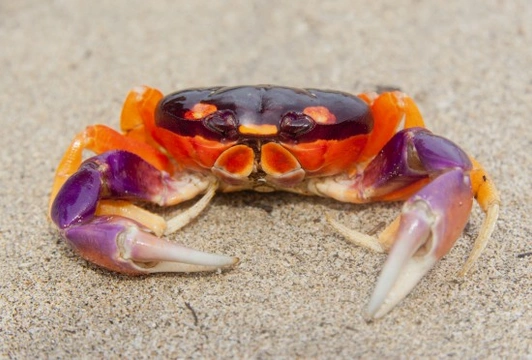
Land Crabs as Pets: Care Guide & Fun Facts
One relatively easy to keep and yet often overlooked pet invertebrate type is the land crab, a type of crustacean that lives mainly on the edges of the water rather than in the seas and rivers themselves.
Land crabs of certain types can be kept as pets within the home, and make for incredibly interesting and educational pets that are relatively low maintenance.
Land crabs require their own tank and equipment setup and cannot be kept in an aquarium with fish, but nevertheless, providing for their needs and looking after them is fairly simple, and requires a time commitment equivalent to that of keeping an aquarium rather than that of a caged animal.
If you think you might be able to offer a home to some of the smaller species of land crab, read on to learn more!
What types of land crabs make good pets?
The two most readily available and commonly kept land crab species in the UK are the Rainbow Land Crab and the Halloween Land Crab. Both of these species of crab are relatively hardy, do not grow too large, and live mainly on the land. However, as with all crabs, they do require access to water, and so their tank should consist of a split between a land area and water that they can use freely as well.
The rainbow land crab is brightly coloured in hues of purple, blue, orange and cream, while the Halloween land crab usually has a black body and orange legs with purple markings on the claws. Both species of land crab are brightly coloured and visually very pretty!
Housing and accommodation for land crabs
Land crabs do not need an enormous tank to be happy, as they are territorial animals that in the wild, restrict themselves to a set area rather than roaming nomadically. Land crabs are best kept in pairs rather than colonies unless you have a particularly large tank with plenty of room for separate territories, as overcrowding can lead to fighting. In order to keep a couple of land crabs, a tank of around two feet long by a food deep and wide is fine.
In order to provide the perfect environment for land crabs, your tank should contain both a beach, and an area of water. Using an appropriate aquarium or reptile sand is the easiest way to do this, building up the sand on one side of the tank to form a bank, which slopes into water that is three to four inches deep. Land crabs will create burrows within the sand bank, and using an appropriate sand that will retain its shape when wet and not collapse inwards onto these burrows is vitally important.
Over time, the water side of the bank or beach will gradually wash into the water area, and so you will need to make provision to support the bank by means of forming dams with aquarium furniture or driftwood in order to help the beach area to retain its shape.
Even though the water area will be small and relatively shallow, you should still provide some means of filtration for the water in order to keep it clean and avoid it from stagnating. A small aquarium filter that can fit underneath the water level is ideal.
Crabs will quite happily eat fish, and so aquarium fish should not be kept in the water part of a crab tank!
Temperature and environment
The sand side of your crab’s tank should be kept moist at all times, and this will usually happen naturally due to contact with the water. If the sand is dry throughout it as well as on the top layer, the environment of the tank may be too dry, or the water area not large enough comparatively to the land area.
Both rainbow land crabs and Halloween land crabs are freshwater dwellers, and so do not require salt water. However, normal tap water should be de-chlorinated and treated in the same way that water for pet fish would be, prior to addition to the tank.
Rainbow crabs and Halloween crabs hail from hotter climates than the average UK house temperature, and so you will need to integrate a heat mat and thermometer into the tank in order to keep the temperature warm enough and constant. Place this under the water area of the tank, so that the heat will be drawn into the land area through the sand. Your thermostat should be set to around 22 degrees Celsius, as any hotter than this may prove too hot for your crabs.
What do they eat?
Crabs are omnivorous, and will eat more or less anything! Crabs are natural scavengers, and in the wild, consume a wide range of foodstuffs including plant matter, fish and anything else that they can find! Hermit crabs are also popular pets and a complete food designed for hermit crabs is also appropriate to feed to land crabs. You can also feed fish food, raw fish, small cubes of frozen and defrosted whole food such as you can buy for aquarium fish, and various vegetables such as potato or apple. Your crabs will also need supplemental calcium to support the growth and health of their shells, which can be provided in the form of a cuttlefish bone in the tank.
Where to buy land crabs
Some larger pet shops sell land crabs, although your best chance of purchasing them comes from buying at a specialist exotic pet or aquarium retailer, or through a private breeder or seller who is knowledgeable about land crabs and how to care for them.
Land crabs are sometimes offered for salein the invertebrates section here on Pets4Homes, so keep checking back!



